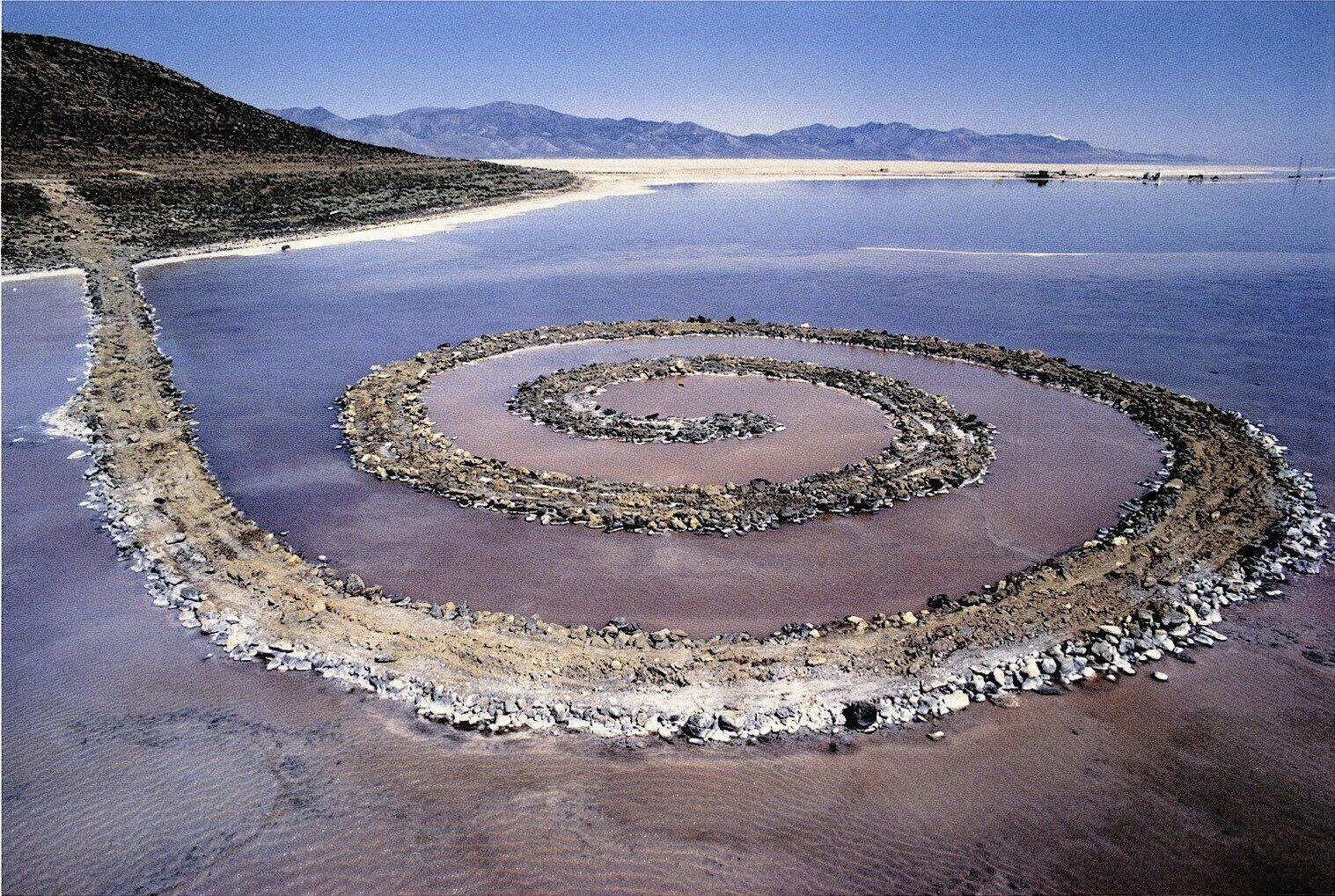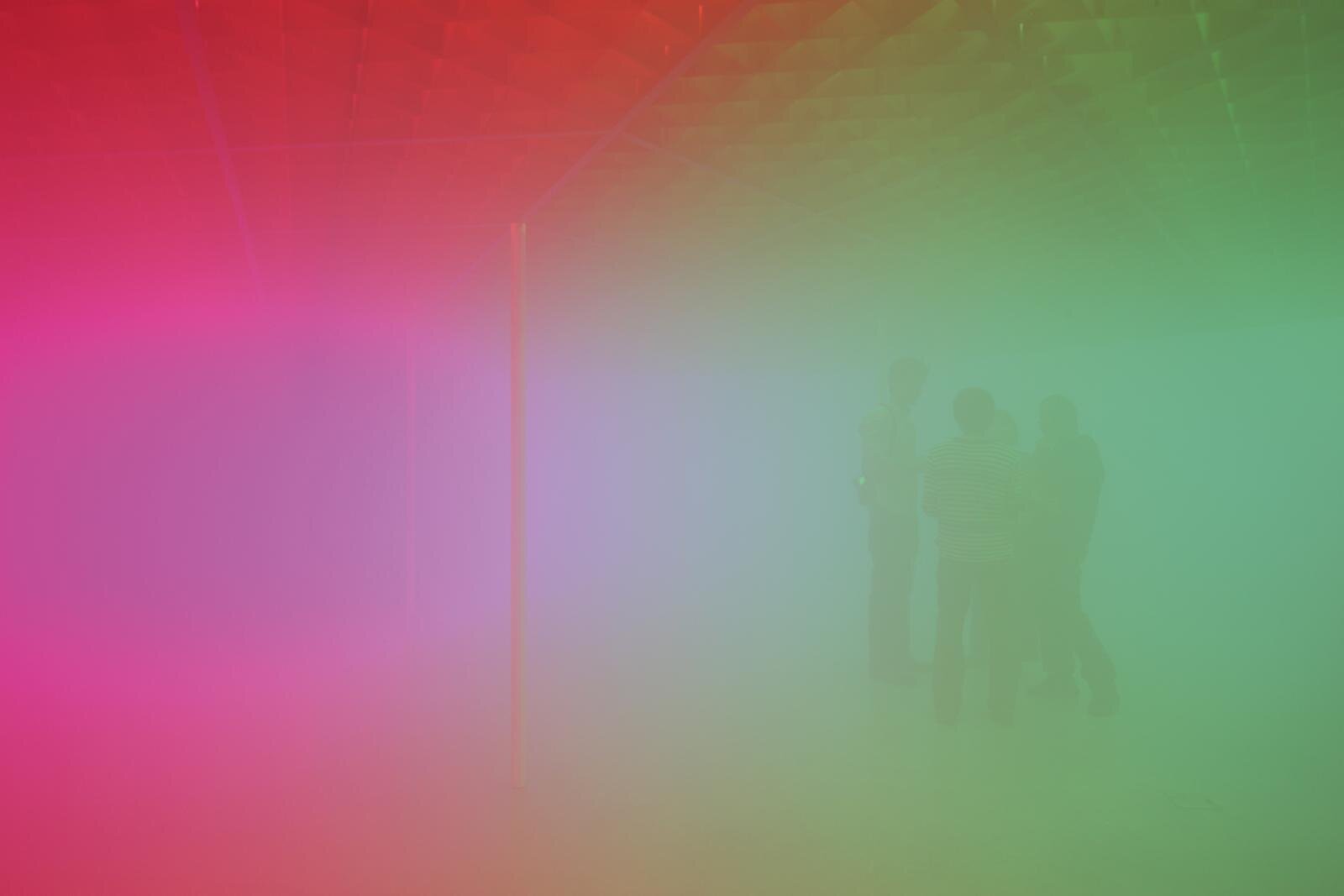Beginning in the 1960’s a group of artists based primarily in New York began to take up the land as the subject and the material for their art practice. Drawing on minimalist and conceptual art they sought to transcend the limitations of classical painting and sculpture in a gallery setting.
They looked to the vast desolate desert spaces of America’s south-west to produce land art on a monumental scale. The artists saw themselves as explorers, looking for a larger canvas to work on in order to produce an art form that would “end galleries”, or so they thought. It seemed as if they wanted to subvert the art market.
Robert Smithson, Spiral Jetty, Great Salt Lake 1970
The unofficial leader of this movement was Robert Smithson who was an eloquent writer and speaker with a dark, even satanic nature. Walter De Maria was said to have been rather quiet and he, like Michael Heizer and many others wanted the viewer to enter the work and experience it. The impact of the Vietnam War must not be underestimated in the development of this art movement, as there seems to be a measure of violence in the production of much land art. There is a belief that the aftermath of the war is an anxiety that hangs over society to this very day, which is also evident in this art form.
Critic Waldemar Januszczak claims land art could not have happened anywhere else. You needed big spaces he tells us. Obviously he’s never been to Australia. Some of the landscapes that appealed to the land artists seem uncannily similar to the Flinders Ranges.
The Apollo moon missions presented us with a new vision of the world as a sphere and the land artists saw this as an opportunity to shape this sphere, to draw on it at a massive scale. The importance of flight can’t be underestimated too. James Turrell often spent days flying at low levels looking for subject matter for his art.
James Turrell, Roden Crater, Arizona commenced 1978
The architecture of the great pyramids is also thought to have been an influence, so we are looking at a confluence of history, architecture and science which inspired land art.
Henry Moore once said that when he made his sculptures he was doing the things he did as a child, and children do have a special relationship with the physical nature of the land. De Maria once said his favourite paint brush was the Caterpillar tractor.
It was the isolation and ruggedness of America’s south-west that appealed most these New York artists. “It is interesting to build a sculpture that attempts to create an atmosphere of awe, awe as a state of mind equivalent to religious experience”, Michael Heizer.
Michael Heizer, Double Negative, appox. 460 m wide Nevada 1969-70
Some may regard Double Negative as an ugly gash on the landscape. Waldemar Januszczak argues land art was about adapting the art to the landscape. Anyway, I would contend that Double Negative isn’t anywhere near as offensive as Mount Rushmore. Of course, nature will eventually fill in these gashes, but both Smithson and Heizer were fascinated by the concept of entropy, that is; of systems breaking down.
A popular hangout for many (but not all) land artists was a bar called Max’s Kansas City in New York City where the owner loved artists to the extent that they were still welcome, even if they didn’t have any money and they could build up a tab or even swap art in exchange. Max’s was extremely inclusive, welcoming people from Europe into constant conversations about art. Carl Andre believes that such openness doesn’t exist today, perhaps because of TV (or the Internet). He even speculates that drugs may have killed it.
Charles Ross, Star Axis, New Mexico commenced 1976
Of course, all major art movements benefit from a patron and in the case of the land artists it was Virginia Dwan. She was a gallery owner with an interest in art as installation which had a relationship to the land and architecture, she was also an heir to the 3M dynasty so money was no object. She was interested in ideas of discovery and would stump up large sums of money for land art projects.
Artist/curator Willoughby Sharp was another supporter of the land artists as they extended their practice outside the gallery environment and he set about promoting their projects by any means possible. He was very media savvy, as evident in his magazine Avalanche which had a European and American art focus.
Nancy Holt and her husband Robert Smithson both grew up in New Jersey and she explained that going back to that state to explore possibilities for future projects gave them a chance to re-experience places they had experienced when children. “It also gave us a chance to unlearn sophisticated things we had learned in early adulthood and getting rid of a lot of useless concepts and getting back in touch with the land, the physical surrounds of our existence and perceiving it in a new way.” But New Jersey had little to offer them, so they headed further west – a lot further west.
A breakthrough for these artists was the Earth Works 1969 show staged by Virginia Dwan at her gallery in New York which introduced the public and media to the whole concept of land art. What followed were major projects funded by Dwan including Michael Heizer’s Double Negative and Smithson’s Spiral Jetty.
Walter De Maria, Lightning Field, New Mexico 1977
In 1977 Walter De Maria produced Lightning Field in New Mexico, 400 steel poles equidistant covering an area 1 km x 1 mile. In this work the viewer is invited to enter and be part of it, the same applies to Double Negative. Dwan explained that when you enter the giant cuts, you can see aeons of existence exposed in the rock layers. She described the experience as lonely, yet feeling at one with nature. There was an element of danger as well, the same applies to Lightning Field if there were any clouds about.
Artists who felt they had burned their bridges with the gallery system found there was another world to explore in land art. Dwan admitted that what she admired most in these artists was their obsession.
In her piece Sun Tunnels, Nancy Holt said that when she explored the south-west deserts for the first time, she found it hard to sleep as it changed her life radically. It gave her a different sense of space, time and light and the power of the sun.
Nancy Holt, Sun Tunnels, Utah 1976
The holes drilled through the concrete pipes are in the configuration of the stars and constellations so that when the sun shines through it creates star light in the tunnels. The tunnels are oriented towards the summer and winter solstice.
It is sad how the changing climate has impacted on Spiral Jetty, now that the Great Salt Lake in the vicinity of Smithson’s work has turned into a desert.
Dwan speculates that it may take another 50, maybe 100 years before the significance of the work of the land artists is fully appreciated. Smithson died in a plane crash in 1973 whilst surveying an area for a future project.
References;
Troublemakers: The Story of Land Art, Summitridge Pictures 2015
Big Sky, Big Dreams, Big Art, Made in the USA, BBC 2018






































